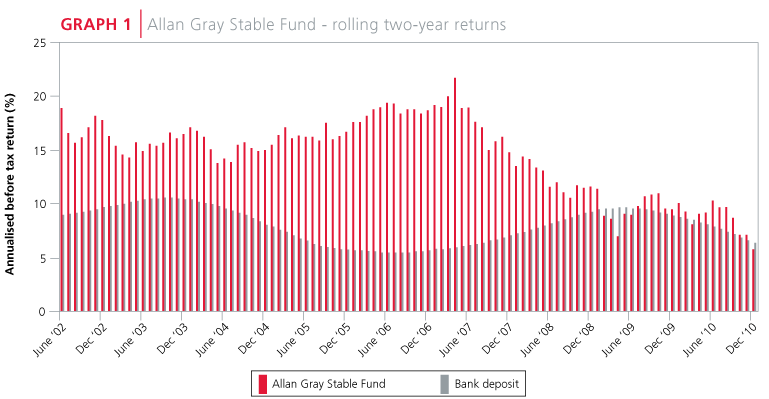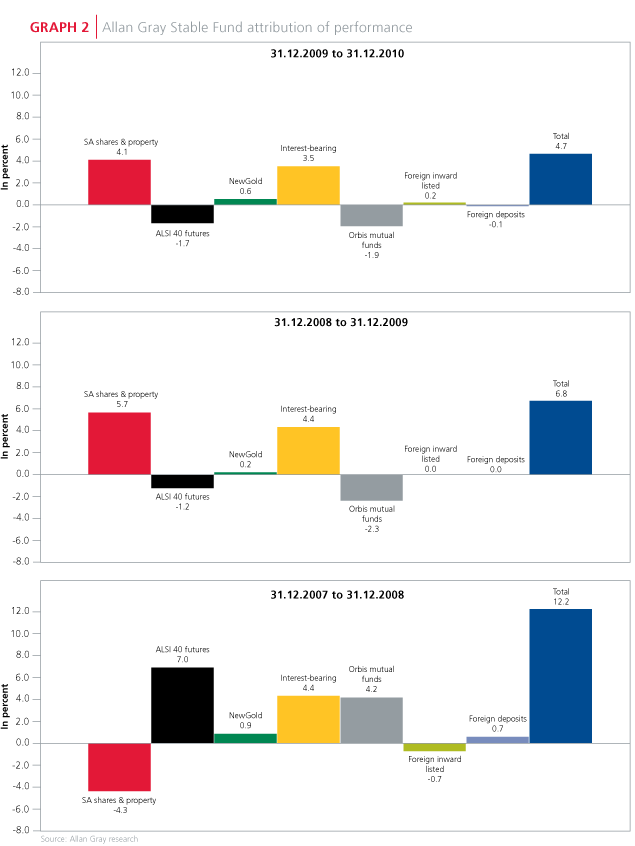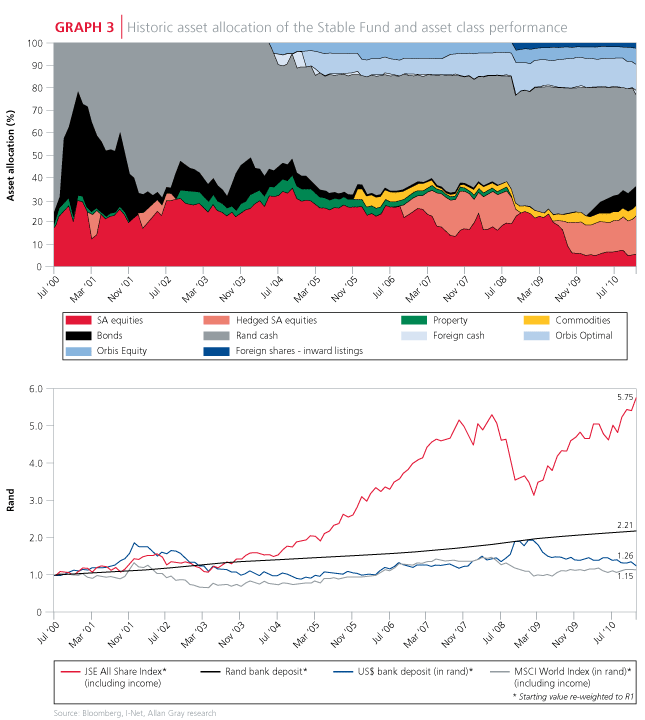The long-term track record of the Allan Gray Stable Fund shows returns well ahead of its benchmark and satisfactory capital stability. Nevertheless, the Fund has disappointed some investors recently as its offshore positions have languished under the strong rand and its early move to a more cautious local share exposure has allowed more daring funds in the same category to overtake it on the short-term performance tables. Ian Liddle and Mahesh Cooper analyse the impact of the Fund's foreign positions on its recent performance, examine the history of how the Stable Fund built up its foreign exposure starting in 2004, and explain why the Fund has recently increased its foreign exposure despite the disappointing past performance from its foreign investments.
While it would be nice for the Stable Fund always to be on top of the short-term performance tables, we do not aim for this. We believe that an unhealthy focus on short-term performance can in fact be detrimental to the achievement of the Fund's long-term objectives. When we launched the Stable Fund in July 2000, we had a simple aim: to meet the needs of investors with a low tolerance for capital loss over any two-year period. Ordinarily these investors may have deposited their capital with a bank or in a money market fund. The Stable Fund aims to provide these investors with a superior long-term return to that which they could earn on a South African bank deposit, while seeking to minimise the risk of capital loss over any two-year period. We remain focused on this goal today.
While this goal is easily explained, it is much more difficult to implement. When pessimism prevails and the investing public is fearful, it can be hard to increase exposure to the stock market in a conservative fund like the Stable Fund. This is especially so when the stock market continues to fall and frightened investors are faced with a few negative months. Conversely it is hard to reduce stock market exposure when the market is rising strongly, because it is inevitable that fund investors will feel they 'missed out' for as long as the momentum continues. But we would not want it any other way - it is precisely because these things are hard to do, that we believe we have an opportunity to grow Stable Fund investors' capital over the long term, while preserving it over any two-year period.
Graph 1 shows the rolling two-year returns of the Stable Fund versus a bank deposit. While the more recent returns demonstrate capital stability over a time of extreme volatility, we can understand investors' disappointment that the returns have not exceeded bank deposit returns by as wide a margin as they did in the Fund's earlier years. In many of our commentaries over the last few years we have explained that it is unlikely that we will be able to match these returns whenever an expensive stock market is the starting point, but there is another reason for the Fund's lacklustre returns over the last couple of years.
Looking back
Graph 2 shows the attribution of the Fund's performance for each of 2008, 2009 and 2010. While the Fund's foreign investments in the Orbis funds contributed to returns in 2008, they significantly detracted from returns in both 2009 and 2010. This disappointing performance can be ascribed to a few important factors including a strengthening rand, low developed market interest rates, developed stock markets underperforming emerging markets such as South Africa, and disappointing relative performance from Orbis' stock picks.
AN UNHEALTHY FOCUS ON SHORT-TERM PERFORMANCE CAN IN FACT BE DETRIMENTAL TO THE ACHIEVEMENT OF THE FUNDS'S LONG-TERM OBJECTIVES
The Fund first allocated capital to foreign investments following South African Reserve Bank (SARB) approval in June 2004. The bulk of the Fund's foreign investments are invested in the Orbis funds. In view of the Stable Fund's conservative objectives, the mix of the Orbis funds historically has been skewed towards the Orbis Optimal SA funds, which hedge stock market exposure. Graph 3 shows the historic asset allocation for the Stable Fund since its inception. For the purpose of this article we will focus on the blue-shaded areas which represent the Fund's foreign investments.

By March 2005 the Fund had increased its foreign exposure to the then applicable maximum prudential limit of 15%. It remained close to this limit for a number of years until it received permission to increase its foreign holdings up to 20% in the midst of the September/October 2008 financial crisis. In what seemed like fortunate timing then, the Fund was able to increase its offshore allocation in the early part of the rand's blow-off from around R8 per dollar to its low of R11.85 per dollar. Shortly thereafter, British American Tobacco (BAT) was unbundled from the Fund's holdings in Remgro and Richemont, and it was classified as a foreign 'inward-listed' security, which further increased the portion of the Fund reported as 'foreign', although the underlying exposure to BAT had been there all along as an asset of the domestic companies, Remgro and Richemont.
The Fund's foreign investments have so far proven disappointing for not only the last two years, but for most of the last seven years in which they have been included in the Fund. Indeed, even if one goes back to the Fund's inception date in mid-2000, a simple South African rand bank deposit has performed significantly better than world stock markets or a US dollar bank deposit (see bottom section of Graph 3). So when the SARB and the Financial Services Board (FSB) recently announced an increase in the prudential limit on foreign investments, why did we increase the Fund's foreign exposure to 25%?
Looking forward
Money flows into emerging markets, rising commodity prices and the strong rand may seem to have unstoppable momentum right now, but investors would do well to remember that they probably cannot last forever, and that the foreign portion of the Fund can play a valuable role in the event of these trends reversing just as it did in 2008 (see Graph 2). The disappointing relative performance of the Fund's foreign investments to date makes us more optimistic about their potential to add value to the Fund from this day on, because today they start from a lower relative price.
WE BELIEVE THAT THE CURRENT 25% EXPOSURE OF THE FUND TO FOREIGN INVESTMENTS WILL CONTRIBUTE TO THE ACHIEVEMENT OF ITS OBJECTIVES
The JSE accounts for about 1.3% of the world's stock market capitalisation. In US dollar terms, the FTSE/JSE All Share Index has almost tripled since its lows in late 2008, and at the time of writing is back at its dollar highs of October 2007. One should not forget that after peaking in October 2007 this index lost two-thirds of its dollar value in just under a year. Of course, most stock markets around the world are up substantially from their lows, but not to the same extent as the JSE. At current prices, there must be a very strong probability that Orbis is now able to find better opportunities globally than we can find in the very limited investment universe on the JSE.
A number of measures show that current sentiment towards many stock markets is close to an optimistic extreme, which is cause for caution. But we believe that the considerable stock market hedge held via the Orbis Optimal SA funds, and the exposure to the Japanese stock market and BAT conform with the Fund's conservative objectives. Interested investors can read more about the stocks that Orbis is finding attractive in their investment commentaries which can be found here.


When the Stable Fund was launched in July 2000, conservative South African investors needed their arms to be twisted to take on any South African stock market exposure at all, because they were mindful of the relatively poor real returns on the SA stock market during the 1990s. The Stable Fund performed a valuable role for these investors in allowing them to participate partially in a massive bull market in SA stocks in a low-risk manner.
The Stable Fund continues to aim for the same objectives it had on its first day. Its most significant exposure is still to high quality rand-denominated interest-bearing investments. We believe that the current 25% exposure of the Fund to foreign investments will contribute to the achievement of its objectives. This may seem hard to believe for South Africans who have experienced a decade of much stronger returns on local investments. But then it was hard for many to believe that South African equities would be such a great investment for the Stable Fund a decade ago.